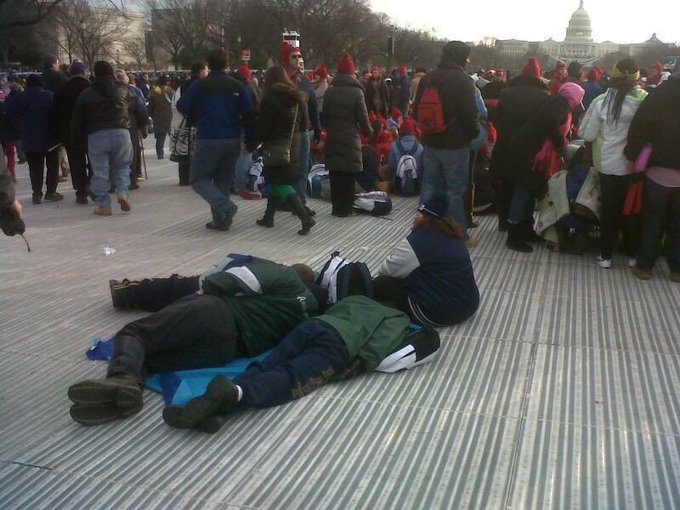

Donald Trump had biggest inaugural crowd ever? Metrics don't show it
At the first press conference of the new administration, White House press secretary Sean Spicer blasted the media, saying they deliberately misled the public about the size of President Donald Trump’s inauguration crowd.
"Photographs of the inaugural proceedings were intentionally framed in a way, in one particular Tweet, to minimize the enormous support that had gathered on the National Mall," Spicer said on Jan. 21. "That was the largest audience to witness an inauguration, period. Both in person and around the globe."
Spicer offered a few "facts" to disprove media reports of low turnout, but many of them are misleading or inaccurate. His overall assertion that Trump’s inaugural drew the "largest audience" ever is flat-out wrong.
Infrastructure issues
Spicer pointed to changes in infrastructure that gave the illusion of low turnout.
It was the "first time" that floor coverings were used to protect the grass on the National Mall, which had highlighted empty spots in the inaugural crowd, an effect not experienced in past inaugurations, he said.
But this is not the case. Floor coverings were also used in 2013, and floor coverings remained on the Mall during the Women’s March on Washington the day after the inauguration.
Spicer also blamed the "first time" usage of fencing and magnetometers on the Mall for "preventing hundreds of thousands of people being able to access the Mall as quickly as they had inaugurations past."
According to a 2017 Congressional Research Service report, screening magnetometers, or metal detectors, have been used in past inaugurations, though it’s not clear if they were placed on the Mall itself. The screening zones, according to the Washington Metropolitan Area Transit Authority, did include two busy metro stops close to the Mall.
Spicer’s claim was also disputed by New York Times reporter Michael Schmidt, who tweeted that two unnamed law enforcement officials told him "magnetometers were not used in the areas Spicer said they were on the Mall."
Crowd size
Spicer then knocked the press for tweeting out "inaccurate numbers involving crowd size."
"No one had numbers because the National Park Service, which controls the National Mall, does not put any out," he said. "We do know a few things. So let’s go through the facts."
"We know that from the platform from where the President was sworn in to 4th Street holds about 250,000 people. From 4th Street to the media tent is about another 220,000. And from the media tent to the Washington Monument another 250,000 people. All of this space was full when the President took the oath of office."
Many news organizations, including PolitiFact, have noted that it’s difficult to gauge crowd size and that estimates are inconsistent. The National Park Service stopped tallying crowds on the National Mall in 1995 after a dispute over the attendance of the Million Man March.
Spicer’s claim of full spaces on the Mall -- which photographs contradict -- would give Trump a crowd size of at least 720,000, which is higher than preliminary estimates reported in the media but are on par with the 700,000 to 900,000 organizers expected to attend. The President himself touted 1.5 million on Jan. 21 at CIA headquarters. But that still wouldn’t have been the top figure.
Here are the attendance estimates for past inaugurations:
Inauguration
| |
|---|---|
Trump, 2017
| |
Barack Obama, 2013
|
1 million
|
Obama, 2009
|
1.8 million
|
George W. Bush, 2005
|
400,000
|
Bush, 2001
|
300,000
|
Bill Clinton, 1997
|
250,000
|
Clinton, 1993
|
800,000
|
George H.W. Bush, 1989
|
300,000
|
Metro ridership
Spicer said 420,000 used the D.C. Metro public transit on Jan. 20, 2017, compared with 317,000 for President Obama’s 2013 inaugural.
It’s unclear where his 420,000 figure for Trump’s inaugural comes from, but the Washington Post reported that for Trump’s inaugural around 570,557 took trips in the system between 4 a.m and midnight on Friday. Inauguration day 2013 drew more, at about 782,000.
Spicer’s 317,000 figure refers to ridership as of 11 a.m. on Jan. 21, 2013, reported the WMATA. Trump’s inaugural drew about 193,000 as of the same time.
Here’s a breakdown of ridership of the most recent inaugurations:
Day
|
Metro ridership (whole day)
|
Metro ridership (as of 11 a.m.)
|
|---|---|---|
Jan. 20, 2017 (Trump inaugural)
| ||
Jan. 21, 2013* (Obama inaugural)
| ||
Jan. 20, 2009 (Obama inaugural)
| ||
Jan. 20, 2005 (Bush inaugural)
|
*Note: Obama’s second inauguration was Jan. 21 instead of Jan. 20, which fell on a Sunday.
Our ruling
Spicer said, "That was the largest audience to witness an inauguration, period."
To support his claim, Spicer offered a few pieces of misleading or inaccurate evidence.
He said that floor coverings highlighting empty spaces on the National Mall were not used for previous inaugurations, but these were in place for Obama’s 2013 inauguration.
He claimed metro ridership was higher for Trump’s inaugural than for Obama’s 2013 inaugural, but he compared numbers for the morning of Obama’s inaugural to the whole day for Trump’s.
Spicer suggested 720,000 attended Trump’s inauguration, while organizers said they expected 700,000 to 900,000, and Trump himself estimated 1.5 million. All of those figures are less than the 1.8 million people who attended Obama’s 2009 inaugural.
We rate Spicer’s claim Pants on Fire.








